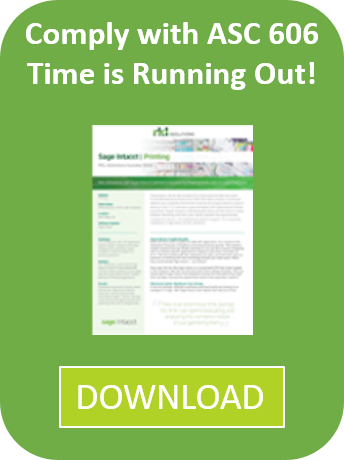At the best of times, getting audited is a painful revenue management time drain—especially all those hours spent hunting down information that auditors want. You burn hours digging through transactions to find the ones supporting out-of-the-ordinary metrics, canvassing the office to find out who changed a transaction and why, or searching through emails to recollect the reason for an oddball journal entry. And with ASC 606, the new guidelines for revenue recognition criteria, time spent with auditors may be even more grueling. Given all the changes that occur in your financials day by day, especially with the dual reporting during the transition to ASC 606, getting access to the information you need is challenging. Sage Intacct ERP not only gives you the financial reports for your audits, it also solves the problem of ready visibility in four ways:
Given all the changes that occur in your financials day by day, especially with the dual reporting during the transition to ASC 606, getting access to the information you need is challenging. Sage Intacct ERP not only gives you the financial reports for your audits, it also solves the problem of ready visibility in four ways:
-
Easy visualization with drill-down capabilities
- First, Sage Intacct gives immediate access to auditable information with role-based, drillable dashboards that can be configured specifically to handle an audit. A dashboard generally shows visualizations such as performance cards (key metrics that summarize account groups), financial reports, and financial charts.
- From a dashboard, you can drill down to the full reports behind the metrics and even to the transactions themselves. And in a multi-entity organization, you can drill down across entities. Instead of jumping all over the financial system or multiple files trying to find what it is that makes something like current year expenses higher than expected, you can just click on the expense metrics and see all the GL information going into that number.
- And because Sage Intacct links related transactions, you could easily view the bill, vendor invoice, fulfillment document (receiver), purchase order, and purchase requisition that led to the expense. The same structure also exists on the purchasing side.
-
Automated audit trails on all transactions
- Next, Sage Intacct builds a continuous audit trail on transactions. You’ll never have to wonder when a transaction changed, or what it was changed from. The audit trail shows what a field value was before, what it was changed to, when it was changed, and who changed it. This effectively eliminates speculation and keeps your organization GAAP compliant.
- The audit trail even extends to changes in process. For example, if you change the rules around your purchasing workflow, the audit trail records include that change. If you create a second version of a vendor invoice just for services and the auditor notices a difference in how expenses are being accounted for, you have an audit trail of what, when, and who that quickly answers questions.
-
Documenting the why behind the numbers
- Auditors aren’t always satisfied with knowing what was done and when. That’s why Sage Intacct provides a collaborative compliance tool—internal messaging called Sage Intacct Collaborate—for you to capture why something was done. Sage Intacct Collaborate saves communications made in the context of the record it relates to.
- During an audit later on, the controller can pull up a transaction of interest, with the permanently stored conversation. She can answer an auditor’s questions about not only what was done and when it was done, but why it was done.
-
Audit-ready under ASC 606
- If you sell contracts or subscriptions, Sage Intacct Contract & Revenue Management prepares you for an audit by including a contract checklist and sign-off capabilities for each step. You’ll also be able to see side-by-side comparisons of the accounting treatments for current and new revenue recognition criteria so the differences are easy to see and drill into as necessary.
RKL + Sage Intacct = Pain-free audits
Sage Intacct reduces the cost and pain of audits
By combining deep financial capabilities with instant visibility and access, Sage Intacct reduces the cost and pain of audits—especially with the new revenue recognition criteria. As seasoned financial professionals, the technology experts at RKL understand the challenges of an audit. Rely on our expertise to design and implement a technology solution that simplifies audits, during the transition to ASC 606 and beyond.




